origins of modern architecture
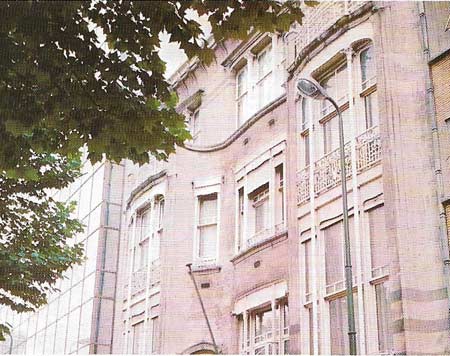
Figure 1. The Solvay House designed by Victor Horta, was built in 1895-1896 for a rich Brussels manufacturer. It is a traditional double-fronted townhouse but its combination of masonry and exposed iron construction was new, and so were many of its formal qualities. The projecting bays are glazed far more expansively than was usual, and their thin iron columns are shaped both to give the impression of growth and, where they carry weight, of gripping and lifting. Also the entire surface of stone gives the impression of a gentle swell, its flanks and the flanks of the bays curving outwards.
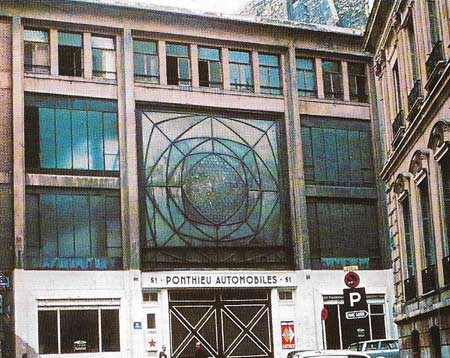
Figure 2. Auguste Perret's 1905 garage on the Rue Ponthieu in Paris uses a reinforced concrete frame. Perrier, almost single-handed, developed the basic techniques for using this new material. He believed that reinforced concrete should be used like timber for frames and panels. The frame and this garage carries all the weight, as can be seen by the areas of glass. The building's structure is plainly expressed in the simple vertical and horizontal organization of the façade. The classical pillars, the small row of windows like a freeze above and the projecting cap are all features however, of the Ecole des Beaux Arts tradition.

Figure 3. The Schroder House on the outskirts of Utrecht was designed by Gerri Rietveld in 1924. The exterior (A) is brick built, with steel posts to support the projecting balconies only where necessary. Outside walls were white and grey, creating a neutral ground for the colored horizontals and verticals. In the interior (B) large areas were in primary colors and white.
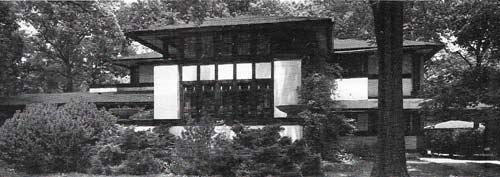
Figure 4. The Ward W. Willitts House in Highland Park, a suburb of Chicago, was built in 1902 by Frank Lloyd Wright. It was on of his "prairie houses". These were low, spreading houses, with open-plan interiors, terraces merging into the landscape and low, sloping roofs. The construction is traditional wooden post and beam. They were among the early Wright designs.
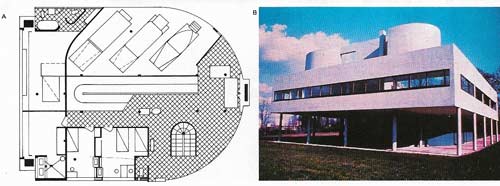
Figure 5. The Villa Savoye (B) at Poissy, east of Paris, was designed by Le Corbusier in partnership with his cousin between 1929 and 1931. The plan of the ground floor (A) shows the curved end of the structure and the way that car space is incorporated into the building to preserve the idea of self-contained structure. Living quarters are mainly on the first floor, which is largely open plan, together with some services. There are four more rooms at ground level.
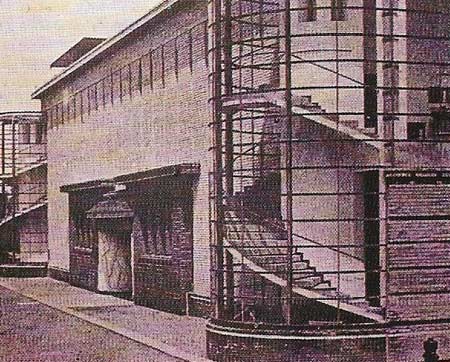
Figure 6. Walter Gropius's factory, built for the Cologne Werkbund exhibition in 1914, is one of the first wholly modern buildings. The office building with its sheets of glass wrapped around both ends and its glazing bars of steel establishes a clear rhythm. The horizontal slabs capping the short tower show the influence of Frank Lloyd Wright. Contrasts between transparency and opacity were to become common in this style.
Modern architecture followed on the Industrial Revolution. Its styles were adapted to the discoveries of the engineers and to the mass production of materials such as iron and steel. The new movement began in France and Belgium and one of the most passionate advocates of a new style was Eugene-Emmanuel Viollet-le-Duc (1814–1879), who claimed that iron construction must lead to new kinds of support and vaulting, and therefore a new architecture. The Paris Exhibition of 1889, for which the Eiffel Tower was constructed, proved him right.
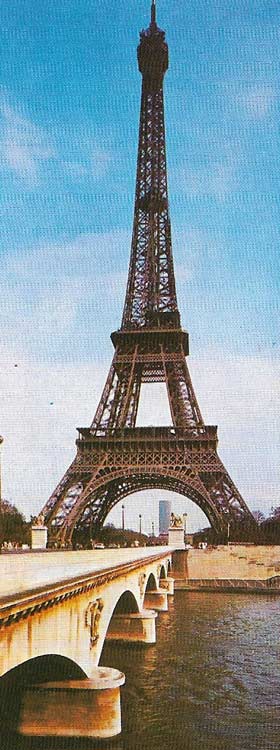 |
| The Eiffel Tower was designed by Gustave Eiffel (1832–1923) for the 1889 Paris International Exhibition. He was already known as a daring engineer of some superb structures including the Garabit Viaduct. When built, his iron tower was the highest structure ever known. Eiffel was also engineer of the Bon Marche department store in Paris (1876) and of the Statue of Liberty in New York, which was completed in 1886. Both of these use iron structures. |
Art Nouveau in architecture
Towards the end of the century more and more buildings were being constructed in a freer, more naturalistic way. This Art Nouveau style was represented by Victor Horta (1861–1947) in Brussels, Hector Guimard (1867–1943) in Paris and Antoni Gaudi (1856–1926) in Barcelona, who all produced whimsical decorative styles which were free of backward-looking imitation. Horta in particular used decoration to underline slender elegance of iron construction (Figure 1).
However, there was another route towards modern architecture, often openly classical, and better attuned to the needs of mechanized production. This was the style developed by Louis Sullivan (1856–1924) and the Chicago architects after 1872, by Auguste Ferret (1874-1954) and Tony Garnier (1867–1948) in France after 1900, by Adolf Loos (1870–1933) in Vienna and by Peter Behrens (1868–1940) in Germany.
Perret evolved the basic techniques of using reinforced concrete and his 1905 garage (Figure 2), now demolished, used concrete frames for posts and beams. Sullivan was capable of the most florid flights of decorative fancy, but Penet's dislike of surface decoration was shared by Gamier, Behrens, and Loos, and stark simplicity became a feature of this anti-individualist route into modern architecture. The shape of the building became more important than decoration.
In 1907 German craftsmen and designers formed the Deutscher Werkbund, an organization that studied the problems and application of design. In 1914 the Werkbund held an exhibition at Cologne. Here the differences between the two main routes into modern architecture were thrown into high relief. On one side was the self-expressive architecture of Henri van der Velde (1863–1957), whose style was representative of Art Nouveau, and on the other was the architectural writer Hermann Muthesius (1861–1927), who stood for a functional modem style and a timeless "ideal" beauty. Somewhere in between was a former pupil of Behrens, Walter Gropius (1883–1969), his factory (Figure 6), built for the exhibition, was geometrically simple and played on the effects of transparency and lightness produced by his steel-frame construction.
De Stijl and the Bauhaus
Yet the anti-individualist trend became dominant among those who searched for modem architecture during the 1920s. Headed by the painter Theo Van Doesburg a movement called De Stijl was founded in Amsterdam (1917). By 1923 its leading architect was Gerrit Rietveld (1888–1964), whose Schroder House, with its overlapping rectangles, its lack of complex curves, and its living-room window which turns a corner at first-floor level, pulled together many typically modern features (4). Mies van der Rohe (1886–1969) was active in Berlin and between 1919 and 1928 Gropius headed the Bauhaus in Weimar and Dessau, which produced the first designs for "modern" furniture and fittings to be manufactured on any scale by industrialists. In France Charles-Edouard Jeanneret (1887–1965), known as Le Corbusier, took reinforced concrete architecture beyond the traditional classicism of his teacher, Perret. He got rid of the cornice, invented the horizontal window and avoided symmetry. His Villa Savoye (Figure 5) has all these features and an openness in its planning also found in the architecture of Gropius, Mies van der Rohe and Rietveld.
Towards an "International Style"
Planning as open as this was made possible by the fact that with steel or reinforced concrete construction internal walls were no longer needed to carry roofs, but it followed too from the desire for a more informal way of life coupled with a closer relationship between the house and nature outdoors. Frank Lloyd Wright (1869–1959), the most gifted of Sullivan's pupils, stressed the organic nature of architecture. He believed that a building, like a living organism, must "grow" out of its surroundings. Between 1893 and 1911 Wright built a number of small suburban houses (the "prairie houses") which were planned outwards from a central hearth. The open planning and flying horizontals of houses like the Willitts House (1902) (Fig 4) made a great impression on Gropius, the early architects of De Stijl, and many others in Europe before 1914.
The individualistic modern alternative in architecture was never halted but during the 1920s the inventive styles of Gropius, Mies van der Rohe, Le Corbusier, and De Stijl, characterized by an asymmetrical arrangement of simple geometric forms, by extensive glazing often turning corners, and by open planning, gave the illusion of a single modem style. It was this that led to the term "International Style", and the attempt, in the next decade, to create a modern international architecture based on shared convictions.
